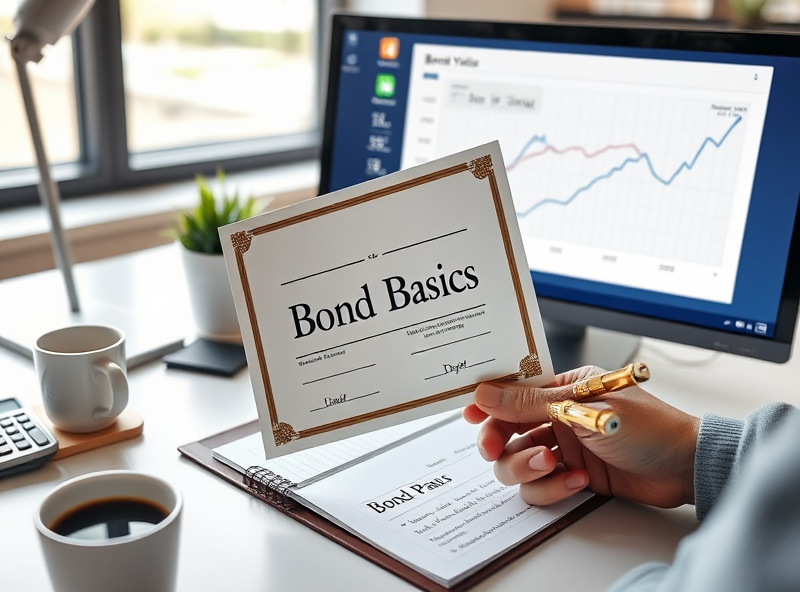
Bond Investing 101: Smart Alternatives Beyond Stocks

Hey there, savvy investors! 👋 Are you looking to diversify beyond the stock market roller coaster? You’ve come to the right place! Today, we’re diving deep into the world of bond investing – a fantastic way to build steady wealth while sleeping soundly at night.
Whether you’re a seasoned investor or just starting your financial journey, understanding bonds can be a game-changer for your portfolio. Let’s explore how these reliable investments can help you achieve your financial goals with confidence!
Bond Investment Basics: Your Foundation for Financial Success
Think of bonds as the steady, reliable friend in your investment circle. When you buy a bond, you’re essentially becoming a lender – pretty cool, right? You’re lending money to governments, cities, or companies, and in return, they promise to pay you regular interest (called coupons) plus your original investment back at a specific date.
The Three Main Types of Bonds You Should Know
1. Government Bonds: The Safe Haven U.S. Treasury bonds are backed by the full faith and credit of the U.S. government, making them incredibly secure. They typically offer lower returns, but hey – sometimes steady and reliable beats exciting and unpredictable!
2. Municipal Bonds: The Tax-Smart Choice These bonds are issued by states, cities, and local governments. The best part? The interest is often tax-free at the federal level, and sometimes at the state level too. That’s more money staying in your pocket!
3. Corporate Bonds: The Higher Yield Option Companies issue these bonds to fund their operations or growth. They generally offer higher interest rates than government bonds, but with slightly more risk. It’s all about finding the right balance for your comfort level.
Essential Bond Terms Every Investor Should Master
- Coupon Rate: This is your “salary” from the bond – the interest rate you’ll receive
- Maturity Date: When you get your original investment back (like a loan repayment date)
- Credit Rating: Think of this as a report card showing how likely the issuer is to pay you back
- Face Value: The amount you’ll receive when the bond matures (usually $1,000)
Individual Bonds vs. Bond ETFs: Making the Right Choice for Your Portfolio
This is where bond investing gets really interesting! You have two main paths to choose from, and both have their unique advantages.
Individual Bonds: The Direct Approach
When you buy individual bonds, you’re in the driver’s seat. You know exactly what you own, when you’ll get paid, and when your investment will mature. This approach is perfect if you:
- Want predictable income streams
- Plan to hold bonds until maturity
- Have specific financial goals with set timelines
- Prefer having direct control over your investments
The Trade-offs: You’ll need larger minimum investments (often $1,000 or more per bond), and you’ll need to do more research to build a diversified portfolio.
Bond ETFs: The Diversified Route
Bond ETFs are like getting a professionally managed bond portfolio in a single purchase. They’re traded on stock exchanges just like individual stocks, making them super accessible. They’re ideal if you:
- Want instant diversification across hundreds or thousands of bonds
- Prefer lower minimum investments (sometimes as little as the price of one share)
- Value liquidity and the ability to trade during market hours
- Like the convenience of professional management
The Trade-offs: You don’t have control over individual bond selections, and the value can fluctuate more with market conditions.
Which Should You Choose?
For most investors, especially those just starting out, bond ETFs offer the perfect balance of diversification, convenience, and affordability. However, if you have specific income needs and substantial capital to invest, individual bonds might be your preferred route.
Maximizing Your Bond Returns: Smart Tax Strategies That Work
Here’s where bond investing gets really exciting from a tax perspective! Understanding how bonds are taxed can significantly boost your after-tax returns.
The Tax Reality Check
Most bond interest is taxed as ordinary income, which means it could be taxed at rates up to 37% for high earners. But don’t worry – there are several smart strategies to minimize this tax bite!
Retirement Account Magic
Traditional IRAs and 401(k)s: Your bond interest grows tax-deferred, meaning you won’t pay taxes until you withdraw the money in retirement (when you might be in a lower tax bracket).
Roth IRAs: Even better – qualified withdrawals are completely tax-free! This makes Roth accounts particularly powerful for high-yield bond strategies.
Municipal Bond Advantages
Municipal bonds offer a unique tax advantage: most of their interest is exempt from federal income taxes. If you buy bonds from your home state, you might avoid state taxes too! This can be especially valuable if you’re in higher tax brackets.
Asset Location Strategy
Here’s a pro tip that can save you thousands: place your taxable bonds in tax-advantaged retirement accounts, and keep tax-exempt municipal bonds in your regular taxable accounts. This strategy, called “asset location,” optimizes your tax efficiency across your entire portfolio.
Understanding and Managing Bond Investment Risks
Let’s be honest – no investment is completely risk-free, and bonds are no exception. But understanding these risks helps you make smarter decisions and sleep better at night.
Interest Rate Risk: The Primary Concern
When interest rates rise, existing bond prices typically fall. It’s like buying a car – last year’s model becomes less valuable when the new model comes out. This especially affects long-term bonds more than short-term ones.
Smart Strategy: Consider bond laddering – buying bonds with different maturity dates to spread out your risk.
Credit Risk: The Default Possibility
This is the risk that the bond issuer might not be able to pay you back. Government bonds have virtually no credit risk, while corporate bonds carry more risk but offer higher potential returns.
Smart Strategy: Diversify across different issuers and credit qualities, and pay attention to credit ratings from agencies like Moody’s and Standard & Poor’s.
Inflation Risk: The Silent Wealth Eroder
If your bond yields 3% but inflation is running at 4%, you’re actually losing purchasing power. This is particularly important for long-term investors.
Smart Strategy: Consider Treasury Inflation-Protected Securities (TIPS) or I-bonds, which adjust with inflation.
Building Your Perfect Bond Portfolio: Allocation Strategies That Work
Creating the right bond allocation depends on your age, risk tolerance, and financial goals. Here are some time-tested approaches:
The Age-Based Approach
A classic rule suggests holding your age in bonds. So if you’re 30, consider 30% bonds; if you’re 60, perhaps 60% bonds. This gradually shifts you toward more conservative investments as you approach retirement.
The Goals-Based Approach
- Short-term goals (1-3 years): Focus on short-term government bonds or high-quality corporate bonds
- Medium-term goals (3-10 years): Mix of intermediate-term bonds with varying credit qualities
- Long-term goals (10+ years): Can include longer-term bonds and higher-yield options
Geographic and Sector Diversification
Don’t put all your eggs in one basket! Consider:
- Mix of government, municipal, and corporate bonds
- Domestic and international exposure
- Different sectors (utilities, healthcare, technology, etc.)
- Various maturity dates (bond laddering)
Advanced Bond Strategies for Serious Wealth Builders
Ready to take your bond investing to the next level? Here are some sophisticated strategies used by experienced investors:
Bond Laddering
Create a “ladder” of bonds with different maturity dates. As each bond matures, reinvest the proceeds in a new bond at the end of your ladder. This provides steady income and reduces interest rate risk.
Barbell Strategy
Combine short-term and long-term bonds while avoiding intermediate-term bonds. This gives you liquidity from short-term bonds and higher yields from long-term bonds.
Total Return Approach
Focus on the combination of interest income plus capital appreciation rather than just yield. This strategy can be particularly effective in changing interest rate environments.
Getting Started: Your Action Plan for Bond Investment Success
Ready to add bonds to your investment strategy? Here’s your step-by-step action plan:
Step 1: Assess Your Situation
- Determine your risk tolerance
- Identify your investment timeline
- Calculate how much you want to allocate to bonds
Step 2: Choose Your Approach
- Decide between individual bonds and bond ETFs
- Consider tax implications for your situation
- Select appropriate bond types for your goals
Step 3: Start Building
- Open appropriate investment accounts (taxable vs. tax-advantaged)
- Begin with broad market bond ETFs for instant diversification
- Gradually add individual bonds or specialized ETFs as you learn
Step 4: Monitor and Adjust
- Review your bond allocation quarterly
- Rebalance as needed to maintain your target allocation
- Stay informed about interest rate trends and economic conditions
Your Bond Investment Journey Starts Now
Congratulations! You now have the knowledge to start building wealth through smart bond investing. Remember, successful investing isn’t about timing the market perfectly – it’s about time in the market with a well-thought-out strategy.
Bonds can provide the stability and income that stocks simply can’t offer. They’re an essential component of a diversified portfolio that can help you weather market storms while steadily building wealth over time.
Start small, stay consistent, and don’t be afraid to ask questions or seek additional education. The bond market offers incredible opportunities for investors who take the time to understand it.
Your financial future is bright, and bonds can play a crucial role in helping you achieve your dreams. Happy investing!
Remember, this information is for educational purposes only and shouldn’t be considered personalized investment advice. Always consult with a qualified financial advisor before making significant investment decisions. Consider your individual circumstances, risk tolerance, and investment objectives when building your portfolio.







